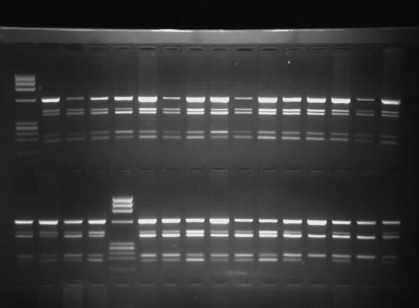© Pint of Science, 2025. All rights reserved.
The very first time I heard the question I was totally unprepared for it. I was at a party, making small talk with an amazingly energetic and intelligent undergraduate student about her degree and her experience of London so far. I mentioned I was starting a PhD in Neuroscience. I thought that might be the end of it, but she was polite enough to ask about the subject of my research so I said: “I’m going to be looking into genetics of schizophrenia”. Her eyes widened… “My father has bipolar disorder, am I going to get it?” I panicked! I didn’t feel I knew enough to answer the question, especially with such high emotional stakes and several drinks deep at a party. Luckily, this particular undergraduate student ended up becoming a dear friend, so we’ve had plenty of time to revisit our conversation over the years. Yet the experience stuck with me and recently I’ve been giving it more thought.
DNA has become an extremely popular molecule in recent years, I believe with good reason (though I am perhaps biased…). People are starting to pay more attention to what we can learn by looking at the information stored in their genetic code. Plenty of businesses have tried to capitalise on this surge in curiosity, offering services ranging from DNA tests that will provide information about your ancestry and propensity to disease to tools that help you design your perfect fitness and wellness program using your genes as a guide.
It’s true that new technology is making genomic analysis quicker and more affordable than ever before, but even having this information might not be enough to predict, say, the probability that we will inherit a disease. Perhaps the question to ask is: what can DNA tell us about ourselves? And further: can we use the tools available for analysing DNA to improve our understanding of ourselves and our quality of life?
Let’s start with the basics – what kind of information would you get from a commercially available DNA test? These services will not produce a full reading of your DNA sequence, which is made up of a series of molecules called nucleotide bases. Instead they look at very specific regions of your genome that are known to be relevant. What they are really looking for are changes in your DNA usually involving only a single nucleotide base. These variants or polymorphisms are scattered throughout our genomes, forming patterns that are unique to each of us. Some elements of the pattern are shared between relatives and can be used to trace ancestry.
Genes provide instructions for producing proteins. Sometimes, polymorphisms can produce a change in these instructions, meaning that more or less protein is produced or even changing the protein altogether. The consequences of this might be relatively harmless; having a particular variant of the OCA2 gene, for example, means having lower or higher levels of P protein, which in turn will help determine eye colour. But sometimes the consequences are more serious. Some genetic testing services look at rare variants in certain genes that have been found to cause disease. A prominent example of this are mutations in the CFTR gene, which disrupt protein function. If a person inherits two faulty copies of the gene, they will develop cystic fibrosis.
Having this kind of information about your own genetic landscape might be extremely interesting and perhaps useful, but all that data still needs analysing and interpreting. Let’s take ancestry, for example; although genetic markers can be traced back a few generations, it’s difficult to establish relations beyond that because, as you climb the family tree, shared markers become more scarce. Added to this is the complexity of genetic background - to provide an estimate of how much of a particular population is reflected in a person’s DNA map (i.e. their ethnicity), the individual’s data has to be compared with these populations. The way in which this is done might change the results slightly or substantially.

In a similar way, if we talk about using a DNA test to predict whether a person will develop a specific disorder, we come across a few complications. The case of cystic fibrosis, where you have one or very few variants causing the disease, is pretty rare. This is why, in clinical settings, genetic testing is only offered under very specific circumstances. If a person has a family history for a particular disease and there are genetic variants known to cause that disease, healthcare professionals might recommend DNA analysis to determine whether that person has a high risk of developing the condition, or for diagnostic purposes if they are showing symptoms. However, for most inherited disorders, even mutations that have been identified cannot explain all cases recorded for the disease. Take the case of BRCA1 and BRCA2; mutations in these genes are known to increase the risk of breast and ovarian cancer, but only ~1-2% of all cases of breast cancer and ~15% of cases of ovarian cancer have a mutation in one of these genes. This means there must be other genes, other variants and other factors involved.
Some people with known mutations associated with a particular disorder never become ill with it and some people with the disease don’t have any of the mutations known to cause it. There are multiple reasons why this might happen. There might be several genes interacting with each other. Environmental factors might be at play. The activation/deactivation of genes might not involve changes in DNA sequence at all, but rather a number of other mechanisms that can regulate gene expression (termed ‘epigenetics’).
This is only the tip of the complexity iceberg. The vast majority of common diseases have a genetic component. However, for most of these disorders, the number of cases that can be explained by mutations in one or a small number of genes is very low. When we talk about genetic factors for these disorders we talk about many common variants, each contributing in small amounts to the risk of developing the disease. This is sometimes referred to, appropriately, as complex disorders. This is the case for schizophrenia and most psychiatric disorders, as well as autism, some types of dementia, type II diabetes, many types of cancer, Crohn’s disease, coronary heart disease, and many others.
For complex diseases, there might be hundreds or thousands of polymorphisms, causing small changes that accumulate to produce the end result. This is what geneticists mean when they use the term ‘polygenic trait’ – literally ‘multiple genes’. In this context, trait means a disease or disorder, but it turns out most of the characteristics that make us who we are (e.g. height or skin/eye colour) are also polygenic traits. In this category we can also include less obvious or distinct characteristics such as intelligence or sexual orientation. Researchers are still trying to figure out the best way to measure these polygenic effects in order to make predictions for individuals or populations about the risk of complex diseases. There is also an interesting debate about the use of these measurements to predict other complex traits, and importantly whether such measurements could lead to us selecting certain ‘desirable’ characteristics. Although fascinating, this ethical discussion is perhaps best left for another time!
Let return to our initial questions. We can perhaps conclude that we can learn a lot about ourselves by analysing our DNA, even if this analysis might be limited. Whether it’s worth paying for a commercially available test is a personal choice. Companies offering DNA tests are careful about stating the limitations of their products, at least the more reputable ones. They might make it clear that when providing a report about a person’s risk for breast cancer, they are only looking for one or a few of the variants associated with the disease and in a very specific gene. But when it comes to things like fitness or weight loss, although companies are relying on real scientific data, the interpretation of the data is so complex that the meaningfulness of any result is questionable. The truth is there are too many variables at play and not enough understanding yet to interpret them accurately. This might improve in coming years as we learn more, but it will take time.
This doesn’t mean commercially available DNA tests have no value. Aside from the fascinating details contained in our genome, which make us utterly unique but also connect us to pretty much every other human being, there is the value of collecting the data itself. The more we know about genetic variation in different populations, the more we can hope to understand about humans as a species. This has implications for medicine, archaeology, history, sociology, the list goes on. And this helps to answer our second question; the tools available are already helping us to increase our understanding of ourselves and hopefully this will lead to an improved quality of life. We have a way to go before we can apply all this knowledge on an individual level, but being part of a collective effort is a very human trait, and one that has taken us far.
About the author:
Dr Cristina Perez-Becerril gained her PhD in neuroscience from Imperial College London, where she researched the genetic risk factors for schizophrenia. She is now based at the University of Manchester where she work to identify and characterising pathogenic variants associated with Neurofibromatoses, a group of genetic disorders that cause tumours to grow in the nervous system. Follow Cristina on Twitter @Opihapaura, or hear more about the work of Division of Evolution and Genomic Sciences in Manchester by following @EGS_UoM.


